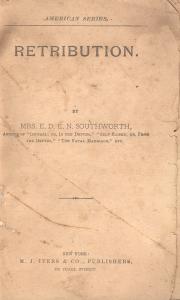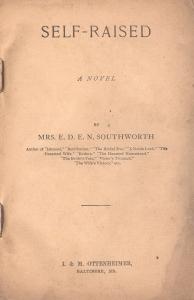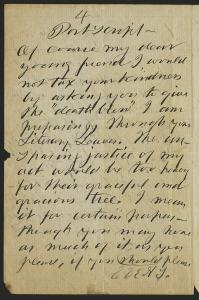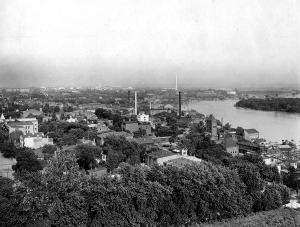Author E.D.E.N. Southworth and her Prospect Cottage
At what is now the corner of 36th and Prospect streets, where the Exorcist House now stands, once stood Prospect Cottage, home to the popular and prolific author Emma Dorothy Eliza Nevitte (E.D.E.N.) Southworth, who moved into the 14 room house in 1850 shortly after returning to Washington. Having been abandoned by her husband several years prior, and caring for two young children, Southworth worked as a school teacher and wrote her stories in the evenings before she was able to support herself entirely from her writing.
Southworth’s first stories were serialized in newspapers, and she published several novel length works in the late 1840s and early 1850s in The National Era, a prominent anti-slavery newspaper published in Washington, D.C. She eventually moved on to write for Richard Bonner’s newspaper The New York Ledger, and her episodic stories began to be collected and published in book form, where over sixty novels would be kept in print by numerous publishers into the 1920s.
Southworth’s legacy is complicated; once seen as staunchly anti-slavery, her works have also been interpreted as apologetic to Southern culture and critiqued for glossing over the true suffering inflicted by slavery, especially as she became more famous and reached a broader audience. Her plantation romances, laden with often heavy-handed moralizing, were dismissed as mere popular fiction, but recent scholarly attention has seen interest in her subversion of the traditional role of women in 19th century America.
Southworth passed away in 1899, and sometime later the Prospect Cottage was transformed into a market and ice cream parlor. In 1928 it was purchased by The National League of American Pen Women with plans of being turned into their headquarters, but was eventually demolished in the 1940s.
Prospect Ave., & 36th Street, Southworth Cottage
Photograph by Willard R. Ross, 1909
University Archives
This photo of Prospect Cottage is taken from the southeast corner looking to the north, approximately from the top of the Exorcist Stairs. The painted advertisement for Coca-Cola adorns the building that now contains the restaurant 1789 and The Tombs.
The National Era, November 29, 1849
General LC Folios ; E446 .N38
Rare Books Collection
This issue of the abolitionist newspaper from Washington, D.C. contains chapters 5 and 6 of the original version of Southworth’s novel The Mother-in-Law: A Story of the Island Estate, serialized in The National Era from November 22, 1849 to July 18, 1850. A year later, The National Era would begin to publish the serialization of Uncle Tom’s Cabin.
Retribution
M.J. Ivers & Co., New York, 1893
American Series No. 316
Rare Books Collection
Retribution, Southworth’s first novel-length work, tells the story of two classmates, Hester Gray and Juliette Summers, who leave school when Hester marries Ernest Dent, a veteran of the Revolutionary War and the son of the guardian of her estate. Hester, believing that her subservience to her husband will result in a happy marriage, is proven wrong as Ernest becomes infatuated with Juliette, and dies a tragic early death after giving birth to her daughter Julie. Ernest takes control of Hester’s estate, unable to fulfill her wishes to manumit the enslaved individuals on the plantation, and marries Juliette, who has no intention of freeing them. After Juliette leaves Ernest it falls to Julie, Hester’s daughter, to fulfill her mother’s desires when she finally comes of age.
Retribution was first serialized in The National Era from January 4th to April 12, 1849.
India: or, The Pearl of Pearl River
M.A. Donohue & Company, Chicago New York
General LC ; PS2892 .I5 1800z
Rare Books Collection
Originally serialized in The National Era in 1853 as Mark Sutherland: or, Power and Principle, the novel’s protagonist returns home from a Northern college to his family’s plantation in Mississippi. Having been recently convinced of the evils of slavery, he embarks on an act of manumission, but his fiancée, the India after whom the book is named, breaks off their engagement under pressure from her uncle, and the rest of his family disowns him. He heads to the territories of the Midwest, where he sets up shop as a small town lawyer, and eventually becomes a successful politician. He convinces India to free the enslaved people on her plantation, and years later, after she has forsaken her life of luxury to become a music teacher, they chance upon each other again, she a widow and he a widower, and finally marry.
Ishmael: or, In the Depths with
Self-Raised: or, From the Depths
I. & M. Ottenheimer, Baltimore, MD
General LC; PS2892 .I8 1880z and PS2892 .S4 1880z
Rare Books Collection
In interviews Southworth would frequently say that Ishmael was the novel of which she was most proud. A matter of much speculation upon publication, the novel was eventually revealed to be loosely based upon the life of William Wirt, a lawyer and member of the Virginia House of Delegates before serving as Attorney General of the United States for Presidents James Monroe and John Quincy Adams.
The novel was first published in serial form under the title Self Made: or, Out of the Depths in the The New York Ledger from March 21, 1863 to April 2, 1864. A letter in the Manuscript collection shows that thirty years later she was still fighting unauthorized publication of the story.
Letter from E.D.E.N. Southworth to “My Dear Young Friend”, November 18th, 1894
Miscellaneous Manuscripts Collection 1, Box 15, Folder 18, GTM-GAMMS345
“If you, being in New York, can possibly send me a cutting from the New York Herald of September 5th of Mr Robert Bonner's card upon "Self Made" I shall be infinitely obliged to you and will return the service in any way I can. I want the cutting of that card to use in the preparation of another article in defense of myself against the libel…”
Southworth’s “dear young friend” is likely Edward Bok, whose column “Literary Leaves” was syndicated and published in newspapers nationwide. Written when she was 74 and no longer actively writing novels, Southworth was still fiercely asserting the rights to her work and protecting her public image.
The Hidden Hand with
Capitola's Peril: A Sequel to “The Hidden Hand”
A.L. Burt Company, New York
circa 1908
General LC; PS2892 .H5 1900z and PS2892 .C3 1900z
Rare Books Collection
The Hidden Hand has received more attention from scholars than any of Southworth’s other novels due to its clever protagonist Capitola Black and the novel’s critiques of gender, race, and class. The novel was a popular sensation in its day, being serialized three times in the United States (1859, 1868-69, and 1883), once in England (1858) and launching at least 40 theatrical productions before eventually being published in book form. In 1859 John Wilkes Booth performed in a production in Richmond, Virginia, and in 1861 P.T. Barnum produced a version in New York for his Lecture Room. The story so captured the imagination of American culture that Capitola became the namesake of towns, hats, yachts, and race horses.
The Hidden Hand: or, Capitola the Madcap
G. W. Dillingham Co., Publishers, New York
1898
The Bowen Spy Fiction Collection
Rare Books Collection
View of Georgetown, Washington and Alexandria, Taken from Columbia College, Georgetown Heights, the Quarters of the 69th Regiment of New York.
Wood engraving on paper, from the May 25, 1861 (Volume XII, Number 288) issue of Frank Leslie's Weekly
University Art Collection, 1111.1.3718
Produced from a pencil and ink drawing by Arthur Lumley a month after the outbreak of the Civil War, this engraving shows Southworth’s Prospect Cottage with its distinctive decorative eaves in the foreground of other Georgetown neighborhood buildings. Southworth was abroad in England at the time of this engraving, and did not return until 1862, when she volunteered as a nurse for Union soldiers, often taking them into her home when hospitals were full.
The original drawing, held by the New York Public Library and simply titled “Georgetown, Washington, Alexandria. May '61”, was re-labeled by the newspaper and the scene incorrectly attributed to Columbia College, which later became George Washington University. The two men on the roof of Gervase Hall, which was completed in 1848, were also an embellishment.
View from the south tower of Healy Hall at Georgetown University, looking towards Washington, D.C., with the Washington monument in the distance
Photograph, circa 1890
University Archives
This view of Georgetown shows Prospect Cottage before the construction of the Georgetown Car Barn. The large mound of dirt next to Southworth’s cottage, being used to extend Prospect Street by filling a ravine between what are now 36th and 37th streets, is the subject of a complaint by Southworth in a letter to the mayor of Georgetown.
Letter from E.D.E.N. Southworth to Georgetown Mayor Richard R. Crawford, October 1st, 1858
Crawford Family Papers, Box 1, Folder 72, GTM-GAMMS261
“My garden lies deeply buried under an avalanche of dirt, my young orchard of thirty fruit trees is broken down and destroyed; while still the dirt is continued to be poured in upon me, threatening even the stability of my house itself.”
So writes Southworth to the Mayor of Georgetown about the plight of her home in the face of an encroaching mountain of dirt being used to re-grade Prospect Street, in a letter that would not seem out of place in a contemporary city council meeting. While the mayor’s reply remains unknown, judging from photos taken decades later this was not an issue that was quickly resolved.
View from Georgetown University, looking towards Washington, D.C., with the Washington monument in the distance
Photograph, circa 1908
University Archives
After Southworth’s death Prospect Cottage has now been converted to a cafe and ice cream parlor, while the Georgetown Car Barn construction is complete, although it has not yet been renovated to add its third floor.
Curated by Steve Fernie.
Special thanks to:
Jay Sylvestre, Lynn Conway and Ann Galloway, John Zarrillo and Scott Taylor, Christen Runge and Lulen Walker, Judy Armstrong, and Gary McQuarrie for identifying the original source of the Frank Leslie’s engraving.





























